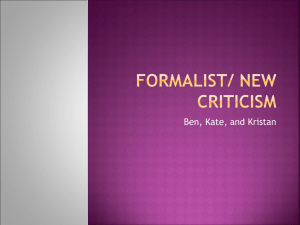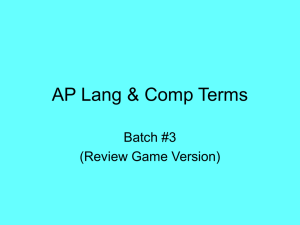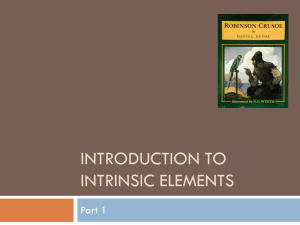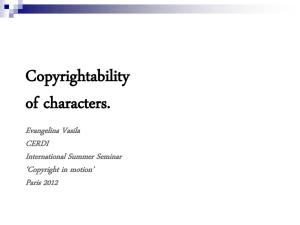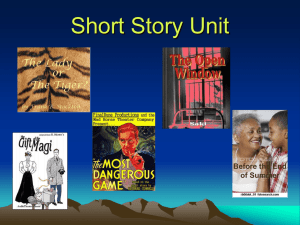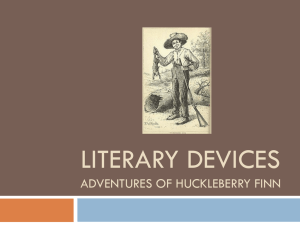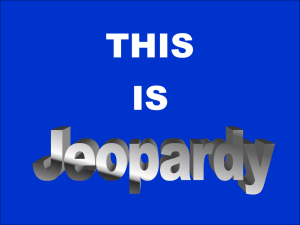AP lang and comp lit term review game 2
advertisement
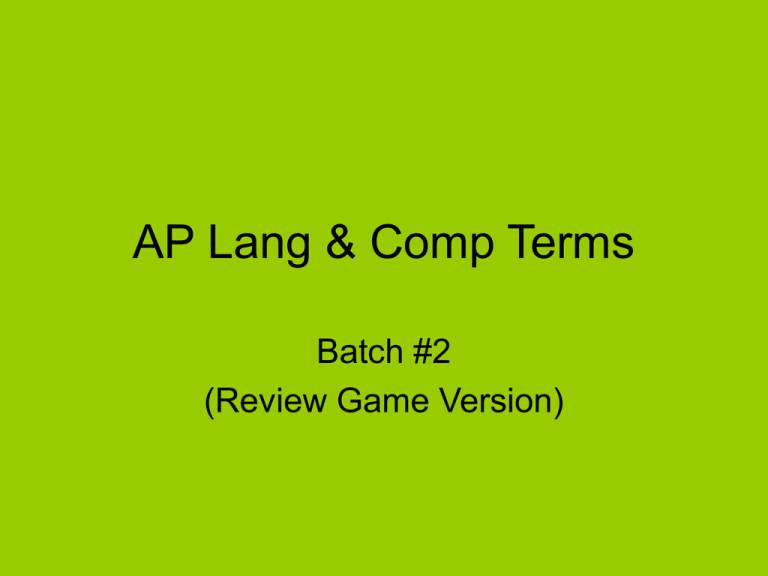
AP Lang & Comp Terms Batch #2 (Review Game Version) #1 Identify the device being used: “Life’s but a walking shadow, a poor player / That struts and frets his hour upon the stage.” (Shakespeare, Macbeth, 5.5.24-25) Answer #1 Metaphor • The comparison of unlike things without the use of like or as #2 Identify the literary device/term: Greek for “wisdom” or “reason”; in the context of rhetoric, refers to the process of persuading by means of logic and reason, as opposed to style, authority, or emotion. Answer #2 Logos #3 Identify the literary device/term: A short narrative that illustrates a moral by means of allegory (in which literal meaning and symbolic meaning correspond clearly and directly). Answer #3 Parable #4 Identify the device being used: “No man is an island.” (John Donne, “Meditation 17”) Answer #4 Metaphor The comparison of unlike things without the use of like or as #5 Identify the device being used: Saying “that was graceful” when someone trips and falls Answer #5 Sarcasm A simple form of verbal irony, in which it is obvious from context and tone that the speaker means the opposite of what he or she says #6 Identify the device being used: Bow-wow. Crackle. Buzz. Zoom. Answer #6 Onomatopoeia The use of words that sound like the thing or action to which they refer #7 Identify the literary device/term: The explicit, literal meaning of a word. Answer #7 Denotation #8 Identify the device being used: Four out of five dentists surveyed recommend sugarless gum for their patients who chew gum. Answer #8 Expert opinion • The citation of accredited authorities in support of an argument #9 Identify the literary device/term: Language that brings to mind senseimpressions, especially via figures of speech Answer #9 Imagery #10 Identify the device being used: The detectives don’t follow the same rules as the uniforms. Answer #10 Metonymy A figure of speech in which something is referred to by one of its attributes. #11 Identify the literary device/term: A figure of speech in which a word pr short phrase is omitted, but easily understood from the context; also the marks (…) that indicates the omission of a word or phrase. Answer #11 Ellipsis #12 • The following are examples: – Wise fool – New antiques – Hot ice Answer #12 Oxymoron The association of two contradictory terms. #13 Identify the literary device/term: One of the types of literature, such as short stories, poetry, drama, and novels, or one of the categories within those types, such as romance, science fiction, mystery, and melodrama. Answer #13 Genre #14 Identify the literary device/term: To present ideas, images, events, or comments that hint at events to come in a story. Answer #14 Foreshadow #15 Identify the literary device/term: From the Greek word for “feeling”; the quality in a work of literature that evokes high emotion, most commonly sorrow, pity, or compassion. Answer #15 pathos #16 Identify the literary device/term: A conversation between two or more speakers; also an exchange of ideas. Answer #16 dialogue #17 Identify the device being used: “The handsome houses on the street to the college were not fully awake, but they looked very friendly.” (Lionel Trilling, “Of This Time, of That Place”) Answer #17 Personification The use of human characteristics to describe animals, objects, or ideas. #18 Identify the literary device/term: An explanation of the meaning or purpose of a piece of writing, especially one that is difficult to understand. Answer #18 Expository #19 Identify the device being used: In Sophocles’ Oedipus Rex, Oedipus vows to discover his father’s murderer, not knowing, as the audience does, that he himself is the murderer. Answer #19 Dramatic irony (also called tragic irony) A technique in which the author lets the reader in on a character’s situation while the character remains in the dark; thus the character’s words and actions carry a significance that he or she is not aware of. #20 Identify the device being used: “My Life has stood—a Loaded Gun—” (Emily Dickinson, untitled poem) Answer #20 Metaphor The comparison of unlike things without the use of like or as #21 Identify the device being used: “We shall fight on the beaches, we shall fight on the landing grounds, we shall fight in the fields and in the streets, we shall fight in the hills.” (Winston S. Churchill, “We Shall Fight on the Beaches”) Answer #21 Anaphora Repeated use of a word or phrase at the START of successive phrases or sentences for effect (Not, oh look! All the sentences begin with “the”!) #22 Identify the device being used: One thousand sails pursued Paris when he fled with Helen of Troy. Answer #22 Synecdoche A figure of speech in which a part of an entity is used to refer to the whole (The SHIPS went after Helen, not just the sails of the ships) #23 Identify the device being used: In Nathaniel Hawthorne’s story “The Minister’s Black Veil,” the black veil worn by one of the characters represents the sins that members of his Puritan community are hiding. Answer #23 Symbol A concrete object that is made to represent something abstract. #24 Identify the device being used: “As Caesar loved me, I weep for him. As he was fortunate, I rejoice at it. As he was valiant, I honor him. But as he was ambitious, I slew him.” (Shakespeare, Julius Caesar, 3.2.23-25) Answer #24 Anaphora Repeated use of a word or phrase at the START of successive phrases or sentences for effect #25 Identify the literary device/term: The main character around whom a story revolves. Answer #25 Protagonist



